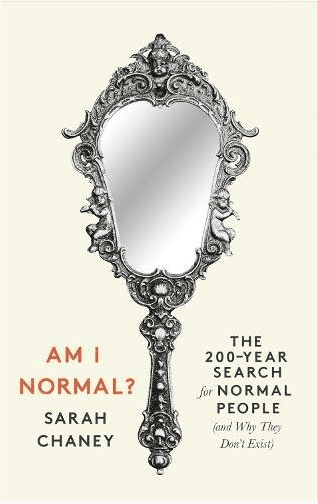Arpan K. Banerjee
Solihull, England

Cover of Am I Normal?: The 200-Year Search for Normal People (and Why They Don’t Exist) by Sarah Chaney
“Am I normal?” is a question that many of us ask at some point in our lives. The existential angst of the twentieth century has resulted in a desire to fit in to society and gain acceptability from peers. The term “normal” was first used in the field of mathematics, but the history and science of normality started around 200 years ago in the West. Before that, people did not really worry about whether they were normal or not. Adolphe Quetelet, a Belgian statistician and astronomer, began asking this question in his 1835 book A Treatise on Man and the Development of his Faculties, or Essay on Social Physics. At the turn of the nineteenth century, the German mathematician Carl Gauss had described the bell-shaped curve. This enabled the description and analysis of populations and started the trend of measuring normality. For instance, the range of human height and weight could be plotted on this graph, enabling the 5% of outliers to be labeled as “abnormal.”
In her fascinating new book, Sarah Chaney discusses the history and science of normality. Her research illuminates the way the concept of normality has often been used to oppress and shame sections of the population who do not conform to so-called ideals. Many of the studies of normality in health and behavior have used small subject groups of mostly white, middle-class, Western people from wealthy industrial countries. While these groups form less than 10% of the world population, they have often been the predominant subjects of study by scientists and healthcare professionals.
The question of what is “normal” is examined in chapters that include the body, mind, sex, feelings, children, and society. Much of the blame for the misinformation about normality is blamed on eugenicists such as Francis Galton and Eugen Fischer, who reached conclusions that were based on little scientific data from small samples of the population. Their analyses were used to justify the claim of superiority of certain racial types. Many studies on intelligence quotient (IQ) have today been discredited and shown to unfairly favor certain groups over others. The medical profession has also been guilty of misusing data to shame sections of society. For instance, at the beginning of the twentieth century in the UK, the comparison of babies’ weights was used to discriminate against and blame mothers for having low-weight babies. It is interesting that a distinguished UK professor of child health, Ronald Illingworth, in 1953 said that it was impossible to determine “normal” in this area of study. It soon became apparent that there is wide variation in weight and size amongst healthy children.
The chapter on sex references studies from Henry Havelock Ellis, Kraft Ebbing, and Alfred Kinsey, whose famous research showed the wide range of human sexual behavior and paved the way for the liberalization of sexual attitudes in Western nations in the second half of the twentieth century. The chapter on feelings and emotions covers the topic of grief with examples taken from the writings of Samuel Pepys and Goethe’s The Sorrows of Young Werther. Manifestations of feeling and emotion are culturally determined. At the turn of the twentieth century in England, it was considered important to be able to control one’s emotions—the so-called “stiff upper lip.” Today there is more awareness of mental health issues, and displaying emotion is deemed more acceptable.
The chapter titled “Is Society Normal?” reminds us of philosopher Herbert Spencer’s quote that “the social organism emerged from the science of the normal.” We are also reminded that in the nineteenth century, it was a commonly held belief that Western societies were superior to non- white cultures. For most of the twentieth century, the culture and habits of middle-class England and America were used to define normality. Today, however, we live in a multicultural society where the statistical label of “normal” cannot be measured from a small, homogeneous sample group, but rather must embrace the diversity of the human population.
This well-researched book is a fascinating read and provides much food for thought and reflection. Perhaps we can conclude that there is no such thing as normal, as all individuals are unique and cannot be defined by a statistical label.
Am I Normal?: The 200-Year Search for Normal People (and Why They Don’t Exist)
Sarah Chaney
Profile Books UK, 2022
ISBN 9781788162456
ARPAN K. BANERJEE qualified in medicine at St Thomas’s Hospital Medical School, London. He was a consultant radiologist in Birmingham 1995–2019. He was President of the radiology section of the RSM 2005–2007 and on the scientific committee of the Royal College of Radiologists 2012–2016. He was Chairman of the British Society for the History of Radiology 2012–2017. He is Chairman of ISHRAD. He is author/co-author of papers on a variety of clinical, radiological, and medical historical topics and seven books, including Classic Papers in Modern Diagnostic Radiology (2005) and The History of Radiology (OUP 2013).

Leave a Reply